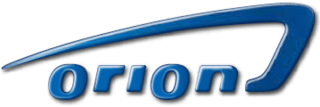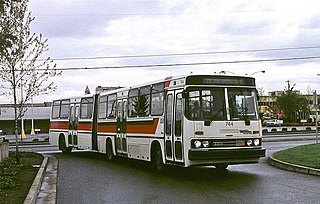North American Bus Industries, Inc. (NABI) was a manufacturer of heavy-duty transit buses with its headquarters, bus manufacturing and assembly operations, located in Anniston, Alabama. Its products ranged from 31-feet to 60-feet in length, and were sold to operators throughout the United States and Puerto Rico. NABI's U.S. operations also include an aftermarket parts division in Delaware, Ohio, and an after-sales service center at Mira Loma, California.

An articulated bus, also referred to as a slinky bus, bendy bus, tandem bus, vestibule bus, stretch bus, or an accordion bus, is an articulated vehicle, typically a motor bus or trolleybus, used in public transportation. It is usually a single-decker, and comprises two or more rigid sections linked by a pivoting joint (articulation) enclosed by protective bellows inside and outside and a cover plate on the floor. This allows a longer legal length than rigid-bodied buses, and hence a higher passenger capacity (94–120), while still allowing the bus to maneuver adequately.

The Neoplan Transliner was a series of related public transport single-decker bus models introduced by Neoplan USA in 1981 and produced until the company declared bankruptcy in 2006. It was available in various lengths ranging from 26 ft (8 m) to 60 ft (18 m) articulated, and was marketed against the Rapid Transit Series, Flxible Metro, Gillig Phantom, New Flyer High Floor, and Orion I.

Nova Bus is a Canadian transit bus manufacturer headquartered in Saint-Eustache, Quebec. Nova is owned by the Volvo Group.

Orion Bus Industries, also known as Bus Industries of America in the United States, was a private bus manufacturer based in Mississauga, Ontario, Canada.

Ikarus was a bus manufacturer based in Budapest and Székesfehérvár, Hungary. It was established in 1895 as Imre Uhry's Blacksmith Workshop and Coach Factory(hun.: Uhry Imre Kovács- és Kocsigyártó Üzeme) and during the Communist era in Hungary it dominated bus markets of the entire Eastern Bloc and its allies.
Neoplan USA was a major transit bus manufacturing company based in Denver, Colorado. It started as a subsidiary of the German corporation Neoplan in 1981 with its main factory and headquarters in Lamar, Colorado. In 1998, Neoplan USA was acquired by Willis Stein & Partners and became an independent licensee of designs from the German company Neoplan. The company declared bankruptcy in 2006.

The Orion V was a line of rigid high-floor transit buses available in 32', 35', and 40' lengths manufactured by Ontario Bus Industries between 1989 and 2009. The conventionally powered buses, either with longitudinally mounted diesel or natural gas engines, used a T-drive transmission coupling. The Orion V replaced the Orion I, and was in turn replaced by the low-floor Orion VI and Orion VII.

The Orion VI was a low-floor transit bus available in 40' lengths manufactured by Ontario Bus Industries between 1995 and 2003. The Orion VI was intended to provide an alternative to the existing high-floor Orion V; both the V and VI were replaced by the partially low-floor Orion VII.

The Orion VII is a line of low-floor transit buses available in 30' rigid, 35' rigid, and 40' rigid lengths manufactured by Daimler Buses North America's subsidiary Orion Bus Industries between 2001 and 2013 in three generations. The conventional powered buses, either with longitudinally-mounted diesel or natural gas engines, used a T-drive transmission coupling. A series hybrid variant powered by a diesel-driven generator was also available. The Orion VII replaced the fully low-floor Orion VI and high-floor Orion V buses, and was manufactured until its parent company DaimlerChrysler withdrew from the transit bus market in 2013.

The Crown-Ikarus 286 is a type of transit bus that was manufactured for the U.S. market from 1980 until 1986, under a joint venture between the Ikarus Body and Coach Works (Ikarus), of Budapest, Hungary, and Crown Coach Corporation from Los Angeles, California in the United States. Loosely based on the Ikarus 280, the Crown-Ikarus 286 is a high-floor articulated bus.

The Low Floor Series (LFS) is a series of transit buses manufactured by Nova Bus for North American customers from 1996 to the present. It is produced in 40' rigid and 62' articulated (nominal) lengths with a variety of powertrains, including conventionally-fueled, hybrid diesel-electric, and battery-electric. The LFS is the first transit bus designed by Nova Bus.

The Orion-Ikarus 286, commonly known as the Orion III, was an articulated bus marketed to Canadian transit operators by Ontario Bus Industries (OBI). It was produced as a joint venture between Ikarus Body and Coach Works and OBI from 1985 to 1989, and deployed primarily in Ottawa and Toronto. The Orion III fleets were retired prematurely due to corrosion, and all examples were withdrawn from service by 2003.

The New Flyer Low Floor is a line of low-floor transit buses that was manufactured by New Flyer Industries between 1991 and 2014. It was available in 30-foot rigid, 35-foot rigid, 40-foot rigid, and 60-foot articulated lengths. In addition to the different available lengths, the buses were sold with a variety of prime movers, ranging from conventional diesel and CNG combustion engines to diesel-electric hybrid, gasoline hybrid, and hydrogen fuel cell.

The MAN SG 220 was a VöV-Standard articulated bus designed and manufactured by Maschinenfabrik Augsburg-Nürnberg (M.A.N.) in Germany between 1978 and 1983, available with two, three, or four doors in two different lengths. The bus was also exported to different countries, built locally in France, Slovenia, Turkey, and the United States.

The New Flyer High Floor is a line of conventional (high-floor) transit buses available in 35-foot rigid, 40-foot rigid, and 60-foot articulated lengths manufactured by New Flyer Industries between 1987 and 2006. The buses were powered by conventional diesel or natural gas engines using either V-drive or T-drive transmission couplings, with the exception of an articulated electric trolleybus variant manufactured for a single customer, the San Francisco Municipal Railway. The New Flyer Low Floor, a low-floor bus with a similar external appearance, was introduced in 1991 and proved to be more popular than the High Floor, which was discontinued in 1996 in diesel rigid form. CNG high-floor buses continued to be made until 1999, and the articulated version was manufactured until early 2006.

The NABI LFW is a line of low-floor transit buses available in 30' rigid, 35' rigid, 40' rigid, and 60' articulated lengths manufactured by North American Bus Industries (NABI) between 1997 and 2015. In addition to the different available lengths, the buses were sold with a variety of powertrains, including conventional diesel, LNG, and CNG combustion engines along with a diesel-electric hybrid system

The NABI CompoBus is a line of low-floor composite-bodied transit buses available in 40' and 45' rigid lengths manufactured by North American Bus Industries (NABI) between 2002 and 2013. In addition to the different available lengths, the buses were sold with a variety of prime movers, ranging from conventional diesel and LNG/CNG combustion engines to diesel-electric hybrid.

The NABI BRT is a line of low-floor transit buses available in 60' articulated (60-BRT) and later 42' rigid (42-BRT) nominal lengths manufactured by North American Bus Industries (NABI) between 2004 and 2015. In addition to the different available lengths, the buses were sold with a variety of prime movers, ranging from conventional diesel and CNG combustion engines to diesel-electric hybrid.

The Alameda-Contra Costa Transit District bus fleet, serving the counties of Alameda and Contra Costa, is the third-largest in California. It was initially formed in 1960 with a mixture of gasoline and diesel-powered buses purchased from its immediate predecessor, the privately owned Key System. The first new buses were purchased for AC Transit in 1960, shortly after its formation and the GM New Look buses were delivered later that year. The transit agency operated GM buses exclusively until 1974, when the first Flxible New Look buses were ordered. Since then, AC Transit has ordered and operated buses from most of the major North American transit bus manufacturers, including Flyer, Gillig, Motor Coach Industries, Neoplan USA, and North American Bus Industries, as well as Van Hool, a Belgian bus supplier.




















